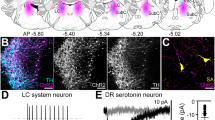Summary
Rat brain cortex slices preloaded with either 3H-serotonin or 3H-noradrenaline were superfused with physiological salt solution, and tritium overflow was evoked by electrical field stimulation.
-
1.
After exposure to guanethidine plus paroxetine (an inhibitor of serotonin uptake) during a 15-min incubation period prior to superfusion, the evoked overflow from slices labelled with 3H-noradrenaline was strongly inhibited, where-as that from slices labelled with 3H-serotonin remained virtually unaffected. In the absence of paroxetine, exposure to guanethidine inhibited the evoked overflow both from slices labelled with 3H-noradrenaline and those labelled with 3H-serotonin.
-
2.
Noradrenaline inhibited the evoked overflow from slices preloaded with 3H-serotonin in a concentration-dependent manner. This effect was not substantially affected by exposure to guanethidine plus paroxetine before superfusion.
-
3.
Intracerebroventricular injection of 6-hydroxydopamine (6-OH-DA) or long-term pretreatment of rats with desipramine did not significantly alter the inhibitory effect of noradrenaline on evoked overflow from slices preincubated with 3H-serotonin.
-
4.
The percentage of 3H-serotonin contained in evoked tritium overflow was neither altered by pretreatment of rats with 6-OH-DA or desipramine nor by exposure of the slices to guanethidine or noradrenaline.
It is concluded that guanethidine inhibits not only noradrenaline but also serotonin release from the corresponding neurones of the cerebral cortex and that the selectivity for serotonin uptake. Acute or chronic impairment of noradrenaline release by guanethidine and 6-OH-DA, respectively, or long-term inhibition of noradrenaline uptake by desipramine does not affect the α-adrenoceptor-mediated inhibition of serotonin release.
Similar content being viewed by others
References
Baumann PA, Waldmeier PC (1981) Further evidence for negative feedback control of serotonin release in the central nervous system. Naunyn-Schmiedeberg's Arch Pharmacol 317:36–43
Boireau A, Ternaux JP, Bourgoin S, Héry F, Glowinski J, Hamon M (1976) The determination of picogram levels of 5-HT in biological fluids. J Neurochem 26:201–204
Cerrito F, Raiteri M (1979) Serotonin release is modulated by presynaptic autoreceptors. Eur J Pharmacol 57:427–430
Cerrito F, Raiteri M (1981) Supersensitivity of central noradrenergic presynaptic autoreceptors following chronic treatment with the antidepressant mianserin. Eur J Pharmacol 70:425–426
Frankhuyzen AL, Mulder AH (1980) Noradrenaline inhibits depolarization-induced 3H-serotonin release from slices of rat hippocampus. Eur J Pharmacol 63:179–182
Göthert M, Huth H (1980) Alpha-adrenoceptor-mediated modulation of 5-hydroxytryptamine release from rat brain cortex slices. Naunyn-Schmiedeberg's Arch Pharmacol 313:21–26
Göthert M, Huth H, Schlicker E (1981) Characterization of the receptor subtype involved in alpha-adrenoceptor-mediated modulation of serotonin release from rat brain cortex slices. Naunyn-Schmiedeberg's Arch Pharmacol 317:199–203
Häusler G, Haefely W (1979) Modification of release by adrenergic neuron blocking agents and agents that alter the action potential. In: Paton PM (ed) The release of catecholamines from adrenergic neurones. Pergamon Press, Oxford New York Toronto Sydney Paris Frankfurt, pp 185–216
Huang YH, Maas JW, Hu GH (1980) The time course of noradrenergic pre-and postsynaptic activity during chronic desipramine treatment. Eur J Pharmacol 68:41–47
Jonsson G (1980) Chemical neurotoxins as denervation tools in neurobiology. Annu Rev Neurosci 3:169–188
Kostrzewa RM, Jacobowitz DM (1974) Pharmacological actions of 6-hydroxydopamine. Pharmacol Rev 26:199–288
McMillen BA, Warnack W, German DC, Shore PA (1980) Effects of chronic desipramine treatment on rat brain noradrenergic responses to α-adrenergic drugs. Eur J Pharmacol 61:239–246
Noble EP, Wurtman RJ, Axelrod J (1967) A simple and rapid method for injecting 3H-norepinephrine into the lateral ventricle of the rat brain. Life Sci 6:281–291
O'Brien RA, Boullin DJ (1972) Accumulation, storage and release of adrenergic neuron blocking agents and related drugs by human platelets. Biochem Pharmacol 21:1817–1827
Petersen EN, Olsson S-O, Squires RF (1977) Effects of 5 HT uptake inhibitors on the pressor response to 5 HT in the pithed rat. The significance of the 5 HT blocking property. Eur J Pharmacol 43:209–215
Raisman R, Briley MS, Langer SZ (1980) Specific tricyclic antidepressant binding sites in rat brain characterised by high-affinity 3H-imipramine binding. Eur J Pharmacol 61:373–380
Schoffelmeer ANM, Mulder AH (1982) 3H-Noradrenaline and 3H-5-hydroxytryptamine release from rat brain slices and its presynaptic alpha-adrenergic modulation after long-term desipramine pretreatment. Naunyn-Schmiedeberg's Arch Pharmacol 318:173–180
Spyraki C, Fibiger HC (1980) Functional evidence for subsensitivity of noradrenergic α2 receptors after chronic desipramine treatment. Life Sci 27:1863–1867
Starke K, Montel H (1973a) Alpha-receptor-mediated modulation of transmitter release from central noradrenergic neurones. Naunyn-Schmiedeberg's Arch Pharmacol 279:53–60
Starke K, Montel H (1973b) Involvement of α-receptors in clonidine-induced inhibition of transmitter release from central monoamine neurones. Neuropharmacology 12:1073–1080
Taube HD, Montel H, Hau G, Starke K (1975) Phencyclidine and ketamine: comparison with the effect of cocaine on the noradrenergic neurones of the rat brain cortex. Naunyn-Schmiedeberg's Arch Pharmacol 291:47–54
Taube HD, Starke K, Borowski E (1977) Presynaptic receptor systems on the noradrenergic neurones of rat brain. Naunyn-Schmiedeberg's Arch Pharmacol 299:123–141
U'Prichard DC, Greenberg DA, Snyder SH (1977) Binding characteristics of a radiolabeled agonist and antagonist at central nervous system alpha noradrenergic receptors. Mol Pharmacol 13:454–473
U'Prichard DC, Bechtel WS, Rouot BM, Snyder SH (1979) Multiple apparent alpha-noradrenergic receptor binding sites in rat brain: effect of 6-hydroxydopamine. Mol Pharmacol 16:47–60
Author information
Authors and Affiliations
Additional information
This study was supported by a grant of the Deutsche Forchungsgemeinschaft
Rights and permissions
About this article
Cite this article
Schlicker, E., Göthert, M. & Clausing, R. Acute or chronic changes of noradrenergic transmission do not affect the α-adrenoceptor-mediated inhibition of 3H-serotonin release in the cerebral cortex. Naunyn-Schmiedeberg's Arch. Pharmacol. 320, 38–44 (1982). https://doi.org/10.1007/BF00499069
Received:
Accepted:
Issue Date:
DOI: https://doi.org/10.1007/BF00499069



